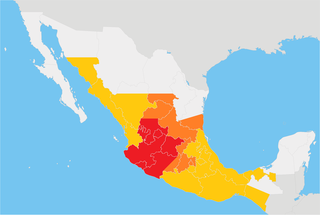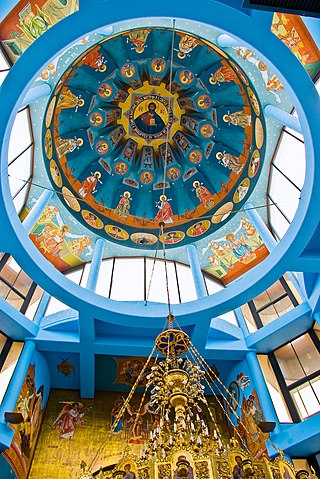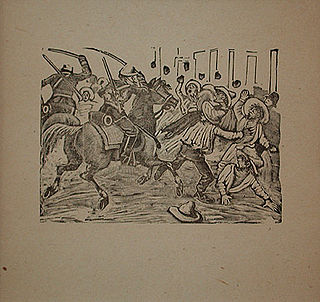
Pope Pius XI, born Ambrogio Damiano Achille Ratti, was the Bishop of Rome and head of the Catholic Church from 6 February 1922 to 10 February 1939. He also became the first sovereign of the Vatican City State upon its creation as an independent state on 11 February 1929. He remained pope until his death in February 1939.

Plutarco Elías Calles was a Mexican politician and military officer who served as President of Mexico from 1924 to 1928. After the assassination of Álvaro Obregón, Elías Calles founded the Institutional Revolutionary Party and held unofficial power as Mexico's de facto leader from 1929 to 1934, a period known as the Maximato. Previously, he served as a general in the Constitutional Army, as Governor of Sonora, Secretary of War, and Secretary of the Interior. During the Maximato, he served as Secretariat of Public Education, Secretary of War again, and Secretary of the Economy. During his presidency, he implemented many left-wing populist and secularist reforms, opposition to which sparked the Cristero War.

Mit brennender Sorge is an encyclical of Pope Pius XI, issued during the Nazi era on 10 March 1937. Written in German, not the usual Latin, it was smuggled into Germany for fear of censorship and was read from the pulpits of all German Catholic churches on one of the Church's busiest Sundays, Palm Sunday.

The Cristero War, also known as the Cristero Rebellion or La cristiada, was a widespread struggle in central and western Mexico from 3 August 1926 to 21 June 1929 in response to the implementation of secularist and anticlerical articles of the 1917 Constitution. The rebellion was instigated as a response to an executive decree by Mexican President Plutarco Elías Calles to strictly enforce Article 130 of the Constitution, a decision known as the Calles Law. Calles sought to limit the power of the Catholic Church in Mexico, its affiliated organizations and to suppress popular religiosity.
The modern history of anticlericalism has often been characterized by deep conflicts between the government and the Catholic Church, sometimes including outright persecution of Catholics in Mexico.

Anacleto González Flores was a Mexican Catholic layman and lawyer who was tortured and executed during the persecution of the Catholic Church under Mexican President Plutarco Elías Calles.
Ad Apostolorum principis is an encyclical of Pope Pius XII on Communism and the Church in China. It describes systematic persecutions of bishops, priests, religious and faithful and the attempts of the government to establish a patriotic Catholic Church, independent of Rome.
Orientales omnes Ecclesias is an encyclical of Pope Pius XII to the faithful of the Ukrainian Greek Catholic Church. It commemorates the three hundred and fiftieth anniversary of the Union of Brest.
Pope Pius XII and Russia describes relations of the Vatican with the Soviet Union, Russia, the Eastern Orthodox Church, and the Eastern Catholic Churches resulting in the eradication of the Church in most parts of the Soviet Union during the Stalinist era. Most persecutions of the Church occurred during the pontificate of Pope Pius XII.
Persecutions against the Catholic Church took place during the papacy of Pope Pius XII (1939–1958). Pius' reign coincided with World War II (1939–1945), followed by the commencement of the Cold War and the accelerating European decolonisation. During his papacy, the Catholic Church faced persecution under Fascist and Communist governments.
Dilectissima Nobis is an encyclical issued by Pope Pius XI on 3 June 1933, in which he decried persecution of the Church in Spain, citing the expropriation of all Church buildings, episcopal residences, parish houses, seminaries and monasteries. He protested "serious offenses committed against the Divine Majesty, with the numerous violations of His sacrosanct rights and with so many transgressions of His laws, We have sent to heaven fervent prayers asking God to pardon the offenses against Him".
Iniquis afflictisque is an encyclical of Pope Pius XI promulgated on November 18, 1926, to denounce the persecution of the Catholic Church in Mexico. It was one of three encyclicals concerning Mexico, including Acerba animi (1932) and Firmissimam Constantiamque (1937). The Mexican government at the time was engaging in violently anticlerical persecution of the Church and the Pope harshly criticised the government for its abuses.

Eastern Catholic victims of Soviet persecutions include bishops and others among the tens of thousands of victims of Soviet persecutions from 1918 to approximately 1980, under the state ideology of Marxist–Leninist atheism.

Holy See–Soviet Union relations were marked by long-standing ideological disagreements between the Catholic Church and the Soviet Union. The Holy See attempted to enter in a pragmatic dialogue with Soviet leaders during the papacies of John XXIII and Paul VI. In the 1990s, Pope John Paul II's diplomatic policies were cited as one of the principal factors that led to the dissolution of the Soviet Union.

Irreligion in Mexico refers to atheism, deism, religious skepticism, secularism, and secular humanism in Mexican society, which was a confessional state after independence from Imperial Spain. The first political constitution of the Mexican United States, enacted in 1824, stipulated that Roman Catholicism was the national religion in perpetuity, and prohibited any other religion. Since 1857, however, by law, Mexico has had no official religion; as such, anti-clerical laws meant to promote a secular society, contained in the 1857 Constitution of Mexico and in the 1917 Constitution of Mexico, limited the participation in civil life of Roman Catholic organizations and allowed government intervention in religious participation in politics.
The Roman Catholic Church in the 20th century entered into a period of renewal, responding to the challenge of increasing secularization of Western society and persecution resulting from great social unrest and revolutions in several countries. A major event in the period was the Second Vatican Council, which took place between 1962 and 1965. The church instituted reforms, especially in the 1970s after the conclusion of the Council, to modernize practices and positions. On taking office part way through the Council, Pope Paul VI referred to "an impatient struggle for renewal".

The Catholic Church in Latin America began with the Spanish colonization of the Americas and continues up to the present day.
The question of whether Freemasonry is anticlerical is the subject of debate. The Catholic Church has long been an outspoken critic of Freemasonry, and some scholars have often accused the fraternity of anticlericalism. The Catholic Church forbids its members to join any Masonic society under pain of interdiction. Freemasons usually take a diametrically opposite view, stating that there is nothing in Freemasonry that is in any way contrary to Catholicism or any other religious faith.
The Mexican Catholic Apostolic Church is an Independent Catholic denomination founded in 1925, by separating from the Catholic Church. It was created to bolster revolution with the support of the Regional Confederation of Mexican Workers (CROM) and Mexican President Plutarco Elías Calles' approval. Its development was marked by several internal crises, followed by consequent splits and mergers. Since 1993, it has been officially listed in the Mexican Federal Registry of Religious Associations.
Leopoldo Ruiz y Flóres was a Mexican prelate of the Catholic Church who served as Archbishop of Morelia from 1911 until his death in 1941. He was previously Bishop of Léon from 1900 to 1907 and Archbishop of Linares o Nueva León from 1907 to 1911.









